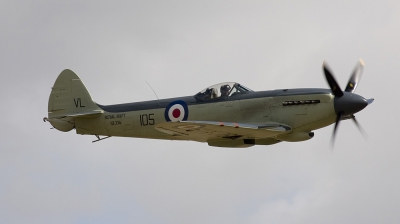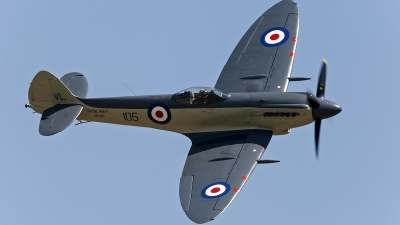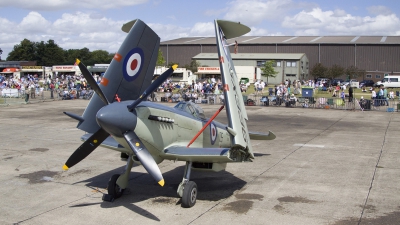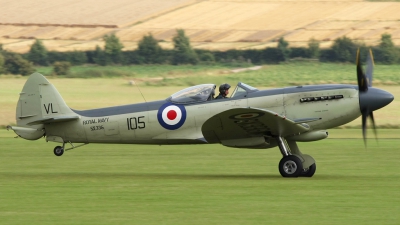Supermarine 384 Seafire F.17 Aircraft Data
As early as 1938 the Admiralty had considered the use of the Spitfire for carrier operations, but it was not until March 1942, that the first Seafire Ib (BL676, a converted Spitfire Vb) took to the air. The first Seafire Ib reached squadron service in June 1942. The first unit to equip, No.801 Squadron was assigned to HMS Furious.
The Seafire II was based on the Spitfire Vc airframe. The first unit equipped with the Seafire II, 807 Squadron, reached operational status in May 1943.
The Seafire III, powered by the Merlin 55, was built in larger numbers than any other Seafire variant. In total 1,220 of the Mk.III were produced, 870 by Westland Aircraft Ltd and the remaining 350 by Cunliffe-Owen Aircraft Ltd at Eastleigh, Southampton.
From Merlin to Griffon Seafires
The Seafire F.XV was the first of the Seafires to be powered by the Rolls Royce Griffon, the 1,735 hp (1,293 kW) Griffon VI. Westlands and Cunliffe-Owen produced 390 aircraft. The Seafire F.XV entered service with No.801 Squadron in May 1945. This type also saw service with the Royal Canadian Navy and in 1951 a number de-navalised aircraft were supplied to Burma (now Myanmar).
Seafire F.XVII (F.17)*
In June 1944 the sixth and final F.XV prototype, NS493, was converted by Westlands to serve as the prototype for the Type 384 F.XVII Seafire. The most significant modifications were the installing of a teardrop cockpit canopy (with a curved windscreen) and the sting-type arrester hook located at the base of the rudder. As on the F.XV, the F.XVII could be catapult-launched in the tail-down position. The aircraft was therefore attached to a single hook under the fuselage centre section and having a hold-back point at the tail.
The Seafire F.17 had the same two-speed, single stage supercharger Griffon VI engine as in the F.XV installed producing 1,735 hp (1,293 kW).
Additional to the 178 Imp Gallon (809 litres, 1,235lb) internal fuel tank, the two fuel tanks in the wing leading edge had a capacity for 145 Imp Gallons (659 litres, 1,079lb) bringing the total internal fuel capacity to 2,405lb (1,090 kg). Furthermore a 33 Imp Gallon (150 litres, 248lb) tank could be installed in the rear fuselage, providing an extra 60 miles range. This tank could be replaced by two F.24 cameras as required.
The F.17 wing spar had been strengthened to allow the fitting of a 22½ Imp Gallon (102 litres, 168lb) jettisonable combat tank under each wing.
The Seafire F.17 entered service with No.883 Squadron in November 1945. This unit had been re-formed on 18 September 1945 at Arbroath as a Royal Canadian Navy squadron equipped with Seafire IIIs. In November the squadron moved to Nutt's Corner to be equipped with Seafire F.XV/XVII.
From May 1947 No.883 Squadron, RCN, operated the Seafire F.17 from her land base at Dartmouth, Nova Scotia, as well as from the carrier HMS Warrior.
Preserved Seafire F.17s
At the moment one Seafire F.17 is airworthy: Kennet Aviation at North Weald, Essex, has SX336 (G-KASX) is in the colours of No.766 Squadron, code 'VL-105' as based at RNAS Yeovilton. This unit operated the Seafire from July 1947 until November 1952.
Work is underway in the United Kingdom to restore another F.17 to airworthy status. This is SX300 (G-RIPH) for Seafire Displays at North Weald.
In the Fleet Air Arm Museum (FAAM) at Yeovilton Seafire F.17 SX137 is on static display. The aircraft is in a standard FAA scheme, with no unit markings applied.
*Note on the Mark designation:
In 1942 role prefix letters were introduced to mark numbers. The change in the use of Roman numerals to Arabic numerals occurred in 1948. The Seafire F.XVII became a Seafire F.17.
The Seafire II was based on the Spitfire Vc airframe. The first unit equipped with the Seafire II, 807 Squadron, reached operational status in May 1943.
The Seafire III, powered by the Merlin 55, was built in larger numbers than any other Seafire variant. In total 1,220 of the Mk.III were produced, 870 by Westland Aircraft Ltd and the remaining 350 by Cunliffe-Owen Aircraft Ltd at Eastleigh, Southampton.
From Merlin to Griffon Seafires
The Seafire F.XV was the first of the Seafires to be powered by the Rolls Royce Griffon, the 1,735 hp (1,293 kW) Griffon VI. Westlands and Cunliffe-Owen produced 390 aircraft. The Seafire F.XV entered service with No.801 Squadron in May 1945. This type also saw service with the Royal Canadian Navy and in 1951 a number de-navalised aircraft were supplied to Burma (now Myanmar).
Seafire F.XVII (F.17)*
In June 1944 the sixth and final F.XV prototype, NS493, was converted by Westlands to serve as the prototype for the Type 384 F.XVII Seafire. The most significant modifications were the installing of a teardrop cockpit canopy (with a curved windscreen) and the sting-type arrester hook located at the base of the rudder. As on the F.XV, the F.XVII could be catapult-launched in the tail-down position. The aircraft was therefore attached to a single hook under the fuselage centre section and having a hold-back point at the tail.
The Seafire F.17 had the same two-speed, single stage supercharger Griffon VI engine as in the F.XV installed producing 1,735 hp (1,293 kW).
Additional to the 178 Imp Gallon (809 litres, 1,235lb) internal fuel tank, the two fuel tanks in the wing leading edge had a capacity for 145 Imp Gallons (659 litres, 1,079lb) bringing the total internal fuel capacity to 2,405lb (1,090 kg). Furthermore a 33 Imp Gallon (150 litres, 248lb) tank could be installed in the rear fuselage, providing an extra 60 miles range. This tank could be replaced by two F.24 cameras as required.
The F.17 wing spar had been strengthened to allow the fitting of a 22½ Imp Gallon (102 litres, 168lb) jettisonable combat tank under each wing.
The Seafire F.17 entered service with No.883 Squadron in November 1945. This unit had been re-formed on 18 September 1945 at Arbroath as a Royal Canadian Navy squadron equipped with Seafire IIIs. In November the squadron moved to Nutt's Corner to be equipped with Seafire F.XV/XVII.
From May 1947 No.883 Squadron, RCN, operated the Seafire F.17 from her land base at Dartmouth, Nova Scotia, as well as from the carrier HMS Warrior.
Preserved Seafire F.17s
At the moment one Seafire F.17 is airworthy: Kennet Aviation at North Weald, Essex, has SX336 (G-KASX) is in the colours of No.766 Squadron, code 'VL-105' as based at RNAS Yeovilton. This unit operated the Seafire from July 1947 until November 1952.
Work is underway in the United Kingdom to restore another F.17 to airworthy status. This is SX300 (G-RIPH) for Seafire Displays at North Weald.
In the Fleet Air Arm Museum (FAAM) at Yeovilton Seafire F.17 SX137 is on static display. The aircraft is in a standard FAA scheme, with no unit markings applied.
*Note on the Mark designation:
In 1942 role prefix letters were introduced to mark numbers. The change in the use of Roman numerals to Arabic numerals occurred in 1948. The Seafire F.XVII became a Seafire F.17.
- Country of Origin: United Kingdom
- First Flight:
- Initial Service Date: November 1945
- No. Built: 232
- No. In Service: 0
- No. of Hardpoints: 3
- Crew: 1
Power:
Rolls Royce Griffon VI at 1,735 hp
Weapons:
Two 20mm Hispano cannon with 120 rounds per cannon and four 0.303inch Browning machine guns with 350 rounds each.
F.17s to operate in the fighter-bomber role had provision to carry a 250lb (113.4 kg) or one 500lb (226.8 kg) bomb on the centreline rack and one 250lb bomb under each wing.
F.17s to operate in the fighter-bomber role had provision to carry a 250lb (113.4 kg) or one 500lb (226.8 kg) bomb on the centreline rack and one 250lb bomb under each wing.
Dimensions:
| Length: | 32ft 3 in. |
| Wing Span: | 36.11 in. |
| Height: | 10ft 8,5 in. |
| Empty Weight: | 6,385 lbs |
| Max. Weight: | 8,148 lbs |
| Internal Fuel: | 2,405 lbs |
Performance:
| Max. Speed: | 383 mph |
Operators:
CanadaNo.883 Squadron, RCN, flew the Seafire F.17 from May 1947 until September 1948.
United Kingdom
The Seafire F.17 equipped over 20 FAA squadrons as well as four Royal Naval Volunteer Reserve (RNVR) units.
FAA: Nos.703, 715, 728, 730, 736, 738, 764, 766, 767, 776, 778, 781, 787, 790, 799, 800, 805, 807, 809, 879 and 899 Squadrons.
RNVR: Nos.1830, 1831, 1832 and 1833 Squadrons.
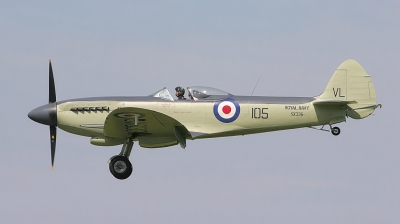
 Random great photos of the Supermarine 384 Seafire F.17:
Random great photos of the Supermarine 384 Seafire F.17:
